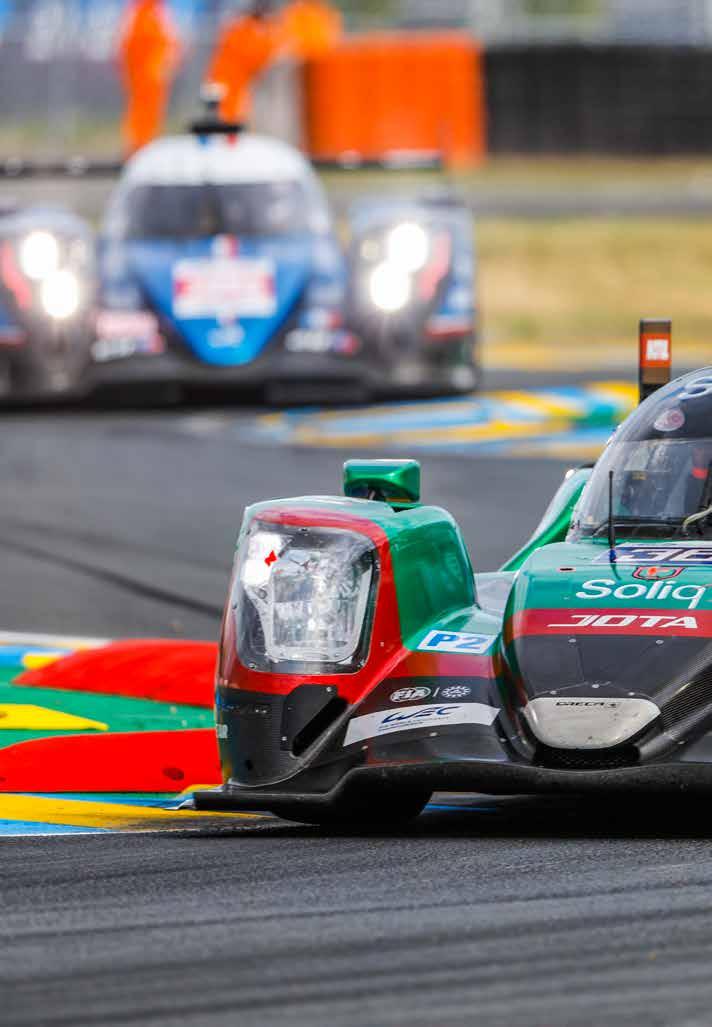
8 minute read
Winning Formula
WINNING
FORMULA
Advertisement
For 20 years Jota has been winning trophies in endurance racing. Now it faces its toughest test yet. Club member and Jota Director David Clark invited us behind the scenes at this remarkable company.

TEN PODIUMS IN the past nine years at the 24 hours of Le Mans, the most gruelling motor race in the world. By any measure, that’s success. Remarkably, it’s been achieved by a small but tightly knit motor racing team located in premises on a farm deep in the Kent countryside. A vast organisation operating out of a multi-million-pound complex in sight of Silverstone it is not.
The day I meet Sam Hignett, co-founder of Jota, and his business partner, and Club member, David Clark, there’s a quiet and steely focus about the place. The team is fresh from victory at Le Mans in June, its third LMP2-class win at the legendary 24hour race, having also won in 2014 and 2017.
Jota’s achievement, in a field of 26 cars, puts them 19 points clear of their nearest rivals in the FIA World Endurance Championship with, as this was written, only two more races, Fuji and Bahrain, remaining. In the workshop is one of the McLarens, number 38, that the team took to eighth place in the other championship that Jota contests, GT3, at Spa 24 Hours just a few days earlier. In a field of 66 cars it was the highest placed McLaren.
Success breeds success but on the evidence of my visit, it clearly doesn’t go to the heads of the calm technicians who help make it happen. Between races, some of them have taken the opportunity to enjoy their summer leave, so perhaps things aren’t quite as intense as they must be with a race looming and all hands on deck. Even so, seeing the technicians who remain tending to some of the most extreme and complex racing cars in the world, I can’t believe that, with the exception perhaps of the pit garage, things ever get too heated.
“Efficiency is the key to everything we
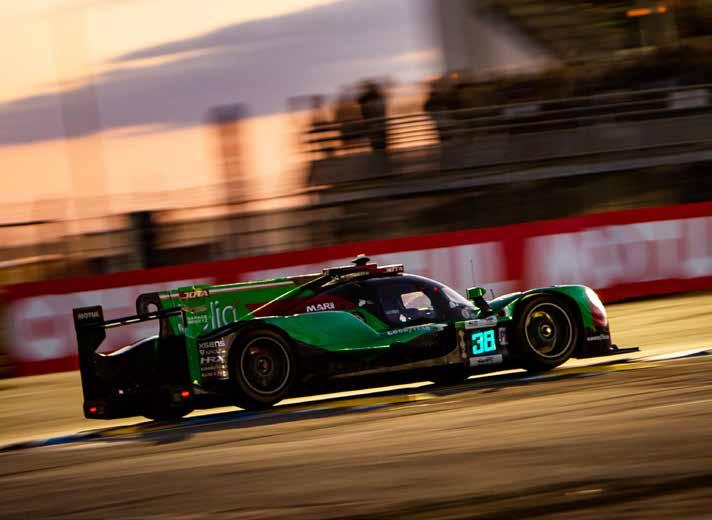
Previous spread: Jota on its way to victory in the LMP2 class at this year’s Le Mans
This page: Racing around the clock at Le Mans is all in a day’s work for Jota, the endurance specialists
LMP AND GT3
To outsiders, the upper echelons of the sports car racing world can be a confusing place, characterised by obscure abbreviations such as LMP2 and GT3. They stand for something but what?
In fact, LMP stands for Le Mans Prototype, a class of race car designed to compete in the World Endurance Championship. Unlike a Formula One car, an LMP car has an enclosed cockpit and all-enveloping bodywork. Some are faster than F1 cars, at least in a straight line. There are three LMP classes: entry-level LMP3, LMP2 and LMP1. In 2021, LMP1 was renamed Hypercar to reflect the introduction of hybrid systems. From next season, it is joined by LMDh (Le Mans Daytona h), also for hybrid racers.
GT3 is a championship for grand tourer racing cars that are based on production models. Jota, for example, fields a pair of heavily modified McLaren 720S sports cars. Other manufacturers competing in the class include Mercedes, Porsche, Audi and BMW. GT World Challenge Europe (GTWCE), comprising multiple one-hour races and endurance races lasting up to 24 hours, is the foremost championship in GT3 and Spa 24 Hours, the pinnacle of the GT3 calendar.
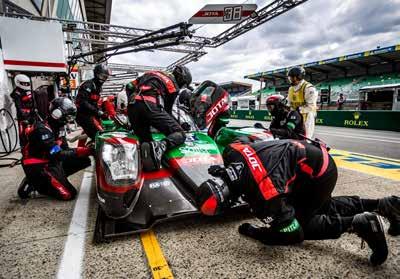
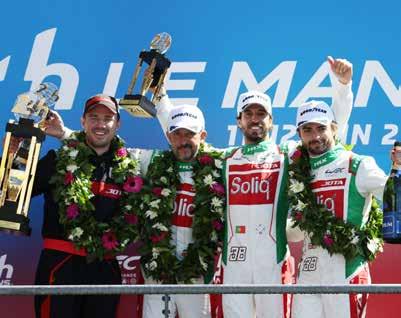
do,” says Hignett. We’re sitting in his office, an unpretentious space for a man, still only in his 40s, who has achieved so much in the 22 years since he co-founded Jota (the name was inspired by the Lamborghini of the same name) with friend and fellow racing driver John Stack.
Hignett has been endurance racing since his student days (he studied materials engineering at university), at the wheel first of a Honda Integra and later a Renault Clio V6 Trophy. In 2002, he and Stack purchased an SR2-class Pilbeam to compete in the FIA Sportscar Championship, finishing second overall in the SR2 championship.
Over the following years Jota’s trophy cabinet began to fill, thanks to successes in endurance racing notably with Zytek, whose factory team they ran, and in racing series including the Porsche Carrera Cup GB. Other race partnerships included those with Charouz Racing Systems and manufacturers Aston Martin and Mazda, while in 2017 they joined forces with Jackie Chan DC Racing
Above, from top: Behind every great driver is a well-rehearsed pit crew; from right, in white, Jota drivers Will Stevens, Antonio Felix da Costa and Roberto Gonzalez celebrate their LMP2 Class win at Le Mans 2022
to run two Oreca 07 LMP2 cars in the 2017 FIA World Endurance Championship.
Engineer, racing driver, team owner and deal maker (as an independent company, sponsorship is key to Jota’s survival) Hignett, along with David Clark who came on board in 2010, spins many plates but rarely drops any. Jota’s dedication to efficiency in everything it does – from its cars’ aerodynamic efficiency to the efficient working practices of the team – is the primary reason for that but there are others, too.
They include consistency, which Hignett believes has been key to Jota’s success. “We’ve stuck with endurance and sports car racing. It’s what we do and have done since the company was formed. It means we understand the circuits and the cars completely and can build on our experience with each passing season. Had we chopped and changed race series, things might have turned out differently.”
Consistency in staffing is another factor Hignett believes has contributed to Jota’s success. “We have fantastic staff retention. Of course, our location far from Northamptonshire and the racing teams who constantly poach each other’s people means they face fewer temptations but we strive to create an atmosphere and a way of working that encourages them to remain.” On that point, Hignett believes very firmly in giving people responsibility. “Not only do they learn their craft but they also learn to take responsibility for their actions. It’s about empowering people and making them self-motivated.”
Equipping the team with the right tools for the job is a given but Hignett goes further

Above: Winning duo David Clark (left) and Sam Hignett
Below: One of Jota’s successful GT3 McLarens enjoys a well-earned rest in the workshop
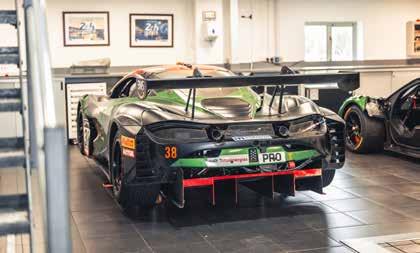
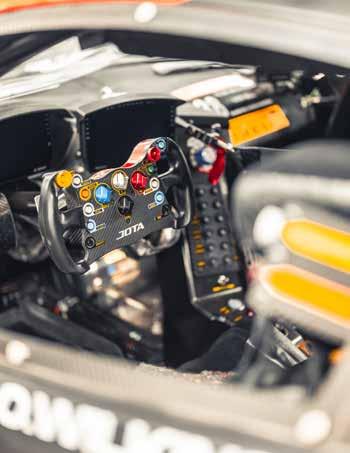
Technology is important when it comes to success but as Jota proves, leadership and team spirit are crucial by encouraging his engineers to explore and devise technical solutions for themselves. “In the main office we have three 3D printers. Any time an engineer conceives a solution for a technical problem, they can use a printer to produce the component for testing. Why wait for solutions when we have the answers right here at Jota?”
Hignett’s last ingredient for success is, of course, fostering a happy working environment. Later, down in the workshop, I sneak a glance at a whiteboard among the cars and components. On it, someone has scrawled the title, ‘The Wall of Philosophy’. I’m keen to see what insights Jota engineers can share. Among the lighter-hearted snippets of wisdom (‘If you aren’t first, you’re last’ and ‘Just because you boil the kettle twice, it doesn’t mean the water is twice as hot’) are pearls including ‘Make sure your words are better than silence’ and, one that’s pertinent for an organisation confronting the unpredictable on a daily basis, ‘Stay away from negative people. They have a problem for every solution.’
Next season, that pearl could prove invaluable as Jota moves up from the LMP2 class in the FIA World Endurance Championship to the top tier: Hypercar. From 2023 this class permits two types of endurance car: LMH and LMDh. Both are very specific hybrid cars combining an electric motor with an internal combustion engine. Jota, an independent team remember, will be fielding a Porsche 963 in the LMDh class against the likes of car makers BMW and Porsche.
“This is the pinnacle; the class every ambitious team strives to enter,” says Hignett. That Jota can do so is thanks, in particular, to the company’s partners, Tom Wagner and Greg O’Hara, who, with their investment companies, are also the new owners of vehicle rental giant, Hertz. They are also closely involved with Singer Vehicle Design, which modifies Porsche 911s to an incredibly high standard. “It is a three-year deal with an option for a further two years that gives us the security and sustainability we need to succeed,” explains Hignett.
Still in the workshop my attention is drawn by a partially dismantled LMP2 car. It’s Jota’s development car and, like all LMP2 cars, it is an Oreca 07 powered by a Gibson 4.2 V8. A veteran of past campaigns (it took pole at Le Mans in 2016, where it also finished second in 2017, and scored victories at Sebring and Fuji) it’s fresh from Jerez where it was engaged in development work for a major tyre company, as well as for Jota’s assault on Bahrain in November where the combination of high track temperatures and an abrasive surface are similar to those found at the Spanish circuit. Perhaps Hignett should have added ‘attention to detail’ to his recipe for success.
Elsewhere, that detail is evident in another string to Jota’s bow: its engineering services division. Located close by, it is home to some of the most advanced metal cutting machines imaginable, producing perfectly shaped and calibrated components for major car manufacturers and their burgeoning electric vehicle programmes. “This business grew out of our race work,” says Hignett. “There’s not a lot we can’t make.”
As Jota ponders its move into endurance racing’s coveted Hypercar class, that talent for self-reliance should prove invaluable.










